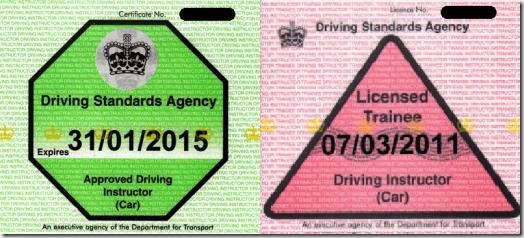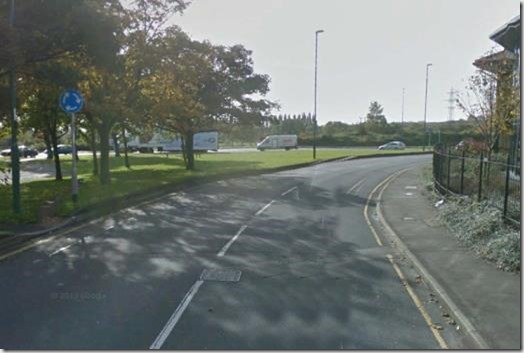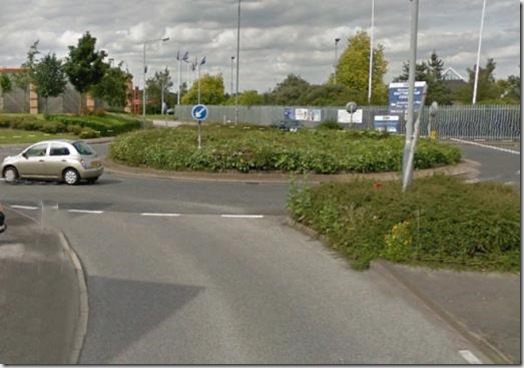OLD ARTICLE – possibly out of date now.
This article was originally written in July 2011. However, there has been a run of hits on it recently, so I’ve updated it (2014).
It’s getting another run of hits (2020). It’s quite amusing looking back, because ten years after the original article, nothing has actually changed! Apart from DSA becoming DVSA.

The BBC reported back in 2011 that the government [was] to review the trainee driving instructor (pink badge) system. As of 2014, nothing has changed and everything is still up in the air, although the proposals are still current. If nothing else, the time scale involved so far should provide a vivid illustration of how long it takes for anything to happen. Personally, I’d be in favour of a revamp for the simple reason that the vast majority of PDIs never become ADIs, yet they are still allowed to teach learners if they opt for the trainee licence route.
The trainee licence is often referred to as a “pink” or “pinkie”, by virtue of the colour of the badge that is issued by the DSA (now known as DVSA). A full ADI licence gets a green badge with an octagon on it, and the trainee one is pink with a triangle. The pink badge provides a means for PDIs who have passed their Part 1 and Part 2 tests to gain experience training real pupils while preparing for the Part 3 test of instructional ability.
The argument that practice makes perfect is quite logical on paper. However, there is no evidence that PDIs who have taken the pink route have higher pass rates at Part 3 than those who didn’t. More on that later.
A PDI who wants to use the pink route has to apply to DVSA. The pink licence is valid for 6 months and can only be extended at the DVSA’s discretion. The full conditions of the trainee licence are given here. Here’s part of the text:
3. Rules for using your trainee licence
You must:
- be a ‘fit and proper’ person
- get the required amount of supervision or extra training while your licence is still valid
- make sure your advertising doesn’t make it seem like you’re a fully qualified instructor
Displaying your licence
You must display your trainee licence on the nearside edge of the front windscreen of your car while you give driving lessons.
Where you work
Your trainee licence shows the name and address of your training establishment. You can only give instruction from there, so you can’t work independently, eg by setting up your own school.
Changing your driving school
You must apply for a new trainee licence if you leave a driving school and join a new one. There’s no fee for doing this.
The Driving Standards Agency (DSA [now DVSA]) will send you a new licence showing the details of your new school. You should send your old licence to DSA as soon as you get the new one.
You can still give driving lessons whole you wait for your new one
When trainee licences can be taken away
The ADI registrar can take your trainee licence away before it runs out if:
- you break any of the rules for having a trainee licence
- the licence was issued by mistake or gained by fraud
- you fail 3 attempts at the ADI part 3 test
Not using your trainee licence
You should return your trainee licence to DSA [now DVSA] if you aren’t using it, eg because of a long period of illness.
You won’t get a refund, but DSA [now DVSA] will know that you haven’t had full use of the licence. This will be a factor in deciding whether to give you another licence in future.
There is more, but this is the main gist. There is no mention of how much a trainee can charge because lesson prices are not part of DVSA’s remit. Interestingly, when The AA took over BSM they made it clear that they were going to introduce differential pricing for PDIs. It is stated in black and white in the news release to BSM franchisees released in February 2011. My understanding is that BSM PDIs now charge £15 per hour for lessons (the actual price may be region dependent), although it is hard to find any of this in writing.
The overall trainee licence conditions are very restrictive… if they’re adhered to. Many PDIs circumvent the issue of not advertising themselves as ADIs by not mentioning their status at all. It’s advertising by implication, since if you don’t explicitly state that you are a trainee, people will simply assume that you are an ADI (no one has ever asked me). These same PDIs advertise freely, sometimes with websites furnished by their trainers, and carefully avoiding any mention that they are only trainees. Others advertise on their own, knowing full well that unless someone reports them, the DSA (DVSA) is unlikely to find out and take their badge away. Many don’t display their badge openly – it will be behind the tax disc or sun visor, or in the glove box (this is sometimes given as specific advice by certain training schools). And in all honesty, the only contact most PDIs have with any “supervisor” is in the classroom. There is virtually no “supervision” while they hold the pink licence or during their in-car lessons. The PDI’s objective is simply to earn money, and their learners are almost always completely unaware of all this.
Both PDIs and training companies are implicated in these shenanigans. It’s a carefully crafted game of chess, designed to bend the rules of the pink licence as far as they will go without actually breaking them, though as I’ve said some people do break them knowing that they’re unlikely to get caught.
PDIs often ask for advice on forums about where to lease cars from, and querying what expenses are tax deductible. Given that it costs upwards of £70 a week to lease a tuition vehicle – plus the fact it takes time to build up a pupil base even for a qualified ADI – a PDI with household bills to pay will be looking way beyond just gaining experience for their Part 3 test. This perhaps explains why the pink route doesn’t seem to improve Part 3 pass rates. Very few people are using it to gain experience or improve their skills – they’re using it to make money as if they were qualified instructors.
If the terms of the trainee licence were enforced, would the pink badge be a good thing? Personally, I believe it would. However, even though many current ADIs used the pink route to get their green badges, they are often staunchly anti-pink now. I know of at least one very frequent and opinionated contributor to several forums who advertised himself clearly as though he were an ADI while he was on a pink. His training school provided website facilities identical to those used by qualified ADIs in order for him to do it. And yet he is against the pink system. It seems that once they become “fit & proper” ADIs they start to vehemently oppose anyone doing precisely what they themselves did.
Another factor driving this anger is that the trainee licence is traditionally associated with larger driving schools such as RED or BSM – reviled by the ignorant masses, and blamed for flooding the market with new ADIs – and (horror of horrors) schools which offer franchises. It is that which the naysayers are opposing, not the pink badge itself.
The original BBC article reports that RED believes trainees should be licensed, because it “brings regulation into an unregulated industry.” RED says clearly that it believes trainees must receive expert training if road safety isn’t to be put at risk.
The DIA reckons that it is wrong for trainees to charge normal lesson rates because they are “less experienced”. I agree, but I would just remind anyone reading this that charging full rate has always been normal practice. Furthermore, no one at the DIA seems to be concerned with the fact that a PDI who hasn’t taken the pink route can pass Part 3 one day, and be out a couple of weeks later giving lessons without ever having done so before.
A driving instructor from Kent – who was on pink – says of his trainer (a large school):
If I needed advice from someone I could always ring up and get that advice but there was no actual supervision or follow-up calls or anything like that,” he said.
The quality of instruction isn’t so good, they may not be in full control of the pupil like a fully qualified instructor would be and some charge the same price for a lesser job.
You can see what I mean about people changing their colours once they become ADIs, can’t you? It worked for him, and he was happy to qualify, but is now critical of his trainers’ methods. This is typical of what happens to many people two seconds after they get their Part 3 pass.
The ADINJC makes the comment in the article:
Someone on a pink licence can actually fail the last part of their assessment to become a fully qualified instructor and on the same day go out and teach learners by themselves.
Yes. It’s always been like that. Nothing has changed. Nothing has degraded. Nothing has got worse. So why say it? What the ADINJC fails to explain is that a PDI has three chances to pass the Part 3 test, and failing one attempt while on the trainee licence doesn’t necessarily mean they are poor instructors, nor does it mean they are any worse than they were before they took the test. They are simply doing what the system allows them to – and always has. It’s what the pink system is.
The ADINJC’s comments also fail to address what I said above – that someone with absolutely no experience teaching real learners can pass Part 3 and be out teaching for real a week or two later, no questions asked! And to really set the cat among the pigeons, people who ultimately turn out to be appalling instructors can still sail through Part 3. There is a lot more that needs to change than just the PDI trainee licence. Poor instruction isn’t confined to PDIs.
As Trevor Wedge [former Chief Driving Examiner] says:
The trainee licence system has been set up to allow trainee driver instructors to gain some practice as they are preparing for the final part of their examination process.
They are encouraged to work very closely with a supervising instructor.
The fact that many trainees don’t work closely with a supervisor isn’t a fault of the system itself. It’s a fault with those who use and abuse the system. The terms of the licence are very specific, and breaching any of those terms is always a deliberate act – even if it is down to plain ignorance.
How do I know what colour badge my instructor has?
Someone found the blog on that precise term.
Simple answer. If his badge in stuck on the windscreen in full view, it’s probably green. If it is nowhere to be seen, it’s probably pink.
Ask him to show it to you. If he won’t, he either hasn’t got one, or it’s pink and he’s claiming otherwise. There is absolutely no reason for an instructor not to show you their badge unless they’re hiding something.
Can a PDI set up their own website?
There’s nothing that specifically says they can’t, but they must not pretend they are fully-qualified ADIs. However, you cannot do it if you are not part of a school – you can’t do it on your own.
It’s a really murky area, because you can argue that not making any claim at all means you’re not saying you are an ADI. However, you could be said to be implying it unless you state categorically that you are a trainee. The Pink Badge is supposed to be a training tool, and you can only advertise as part of your training establishment or school.



 the theory test or to being a safe driver once you have. At worst, it is an obstacle which has to be overcome (it’s pretty obvious that difficulty in reading or comprehending words is going to be an issue, but it doesn’t have to be a terminal one).
the theory test or to being a safe driver once you have. At worst, it is an obstacle which has to be overcome (it’s pretty obvious that difficulty in reading or comprehending words is going to be an issue, but it doesn’t have to be a terminal one).